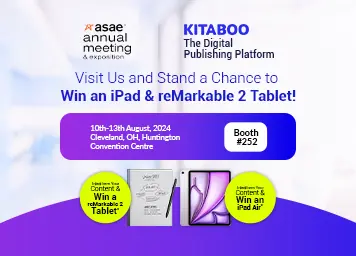Best Practices in Developing Comprehensive eTextbooks
As education goes digital there is an urgent need for publishers to develop engaging eTextbooks and distribute them online. While eBooks have been around for some time, evolving technologies and pedagogical practices have shifted attention to interactive eBooks that engage learners, provide a real-time context, ensure effective knowledge transfer, and shift control of learning from the facilitator to the learner.
Accordingly, to develop effective eTextbooks, you need subject matter expertise, technology know-how and the ability to observe and respond to learner needs. With this in mind, here in this blog, we discuss some of the best practices in developing an effective eTextbook.
Here are some factors to consider while developing an eTextbook-
1. Determine the Age Group of the Students
Who is the target audience of your eTextbook? Is it junior school students or higher education students? What is their level of familiarity with technology?
If you are creating an eTextbook for junior level students, the eTextbook will ideally be designed as support for instructor-led teaching or blended learning. For higher level students, a self-paced learning approach would be a better fit.
Determining the age group of your students will help you choose the right methodology, activities and support resources for your eTextbook. For instance, if the eTextbook is to support skills training, it may include simulated activities, allowing learners to learn by trial and error in a secure environment. Educators can plan the resources and the media elements suitable for the learners.
2. Choose the Appropriate Layout
The layout can be fixed or reflowable. The fixed layout is an exact rendition of a printed page, implying that every aspect of the layout will remain the same on all viewing devices. The reflowable layout is fluid and ‘flows’ to fit the size of the viewing device.
The benefit is that readers accessing the content don’t have to scroll horizontally to read a sentence. The layout you choose will depend on the type of the eTextbook. A fixed layout works best for textbooks with images and illustrations in which layout is critical while reflowable is ideal for text-heavy chapter books and large content distribution.
3. Create Short Learning Content
To design an engaging eTextbook, keep the content short and simple. In a tech-enabled world, students are spoiled for choice when it comes to information. With so many different types of content vying for attention, the golden rule is to keep the content short and effective such that it can hold attention. There are several studies that testify what is a commonly observed phenomenon – people’s attention span is very short. Students today are no longer willing to read through lengthy chapters; rather, they want the main concepts summarized, explained and delivered in as concise a way as possible.
The way forward then is to design microlearning content. Microlearning is a concept that divides large chunks of content into small manageable bites that students can consume and assimilate within minutes. Each microbite is usually about 3 to 5 minutes long and encapsulates concise, to-the-point information about a particular subject . Microlearning not only involves breaking down large chunks of content into smaller bites. Rather it also involves an effective use of technology to present content to increase students’ engagement and interaction.
4. Link to Internal and External Resources
One major advantage of an eTextbook over its print counterpart is that you can link content in an eTextbook to a whole library of internal and external resources. So, if the subject of the eTextbook is Math, you can link certain concepts to simulated or 3D models that help students to visualize and better understand the concept. Then again, learners may want additional information about a subject under discussion. So, while discussing a particular topic, you can hyperlink to a video, PDF or an external website, providing additional information to support or build upon the topic under study. Secondly, you can also hyperlink text internally to other pages of the eTextbook for cross-referencing.
5. Ensure Students Have Device-Agnostic Access
Smartphones have made learning mobile, empowering students to access content anywhere and anytime. This is not to say that classroom learning and instructor-led virtual learning have taken a backseat. To design an effective eTextbook, it is important to ensure that students can access the content on the device of choice, be it the PC in the computer lab, the laptop or tablet at home or the smartphone while on the go. You may also want to deliver the interactive eBook for use on a mobile app or a desktop app.
6. Determine the Digital Technology to Use
There are several types of digital technologies that you can use to make your eTextbook interesting and engaging. You can support content through various media types such as audio, video, infographics, graphics, simulations, game plays etc. The technology you use will depend on the content type, the objectives to achieve and the end-learners – their existing knowledge and the skills to update. Whichever digital technology you use, remember that it should support storytelling and not become the story itself. In other words, technology should effectively communicate the message but not become the message.
7. Protect your eTextbook with DRM
Your eTextbook is your intellectual property which you hope to monetize to your advantage. The Internet, however, makes sharing, copying and downloading content a piece of cake. In an online environment, traditional copyright laws hold no ground. Digital Rights Management, or DRM, is your digital key to lock your content and prevent piracy or any unauthorized use or access. With DRM protection, you can securely distribute your eTextbook over various digital publishing platforms or your own website.
In Conclusion
Emerging technologies and evolving pedagogical practices have redefined education. eTextbooks have come a long way since they were simply a PDF version of their traditional counterparts. What the students want today are textbooks that allow them to interact and engage with the content, understand its practical implications and learn from experience rather than rote. The best practices to develop effective eTextbooks have also evolved over the period.
What sets it apart from the traditional textbook is the art of storytelling using digital technologies. So, leverage an eBook creation platform like KITABOO to create eTextbooks that are interactive and engaging, to provide unparalleled learning experience.
Discover how a mobile-first training platform can help your organization.
Kitaboo is a cloud-based platform to create, deliver & track mobile-first interactive training content.





